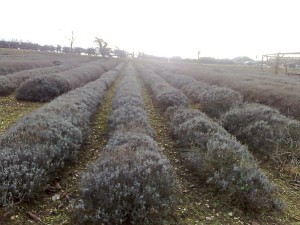- Tahoe’s Nevada Beach Tops the List of Hard-to-Book Campgrounds - 07/17/2024
- Cannabis Watershed Protection Program Cleans Up Illegal Grow Sites - 07/10/2024
- French Fire - 07/05/2024

Some wonder whether our fascination with essential oils is so good for the planet, given that it can take hundreds if not thousands of pounds of plant material to make just one pound of an oil. Pictured: A lavender field at the Norfolk Lavender farm and nursery and distillery in Heacham, Norfolk, England. Photo: Mary Hillary
CONCERNS OVER ESSENTIAL OILS
What’s the skinny on essential oils? I love them, but a friend told me they are no good for the environment.
— Mary M., via e-mail
Essential oils are more popular than ever for medicinal and therapeutic purposes as well as in fragrances and flavorings for food and drinks. Typically produced by harvesting and distilling large amounts of various types of plant matter, essential oils are in many cases all-natural and can take the place of synthetic chemicals in many consumer applications. But some wonder whether our fascination with essential oils is so good for the planet, now that their popularity has turned them into big business.
“It often takes hundreds of pounds of plant material to make one pound of essential oil,” reports aromatherapist and author Mindy Green of GreenScentsations.com. She adds that it takes 50-60 pounds of eucalyptus to produce one pound of eucalyptus oil, 200-250 pounds of lavender for one pound of lavender oil, 2,000 pounds of cypress for a pound of cypress oil and as many as 10,000 pounds of rose blossoms for one pound of rose oil. Production of these source crops takes place all over the world and is often organized by large multinational corporations with little regard for local economies or ecosystems.
“Growing the substantial quantities of plant material needed to produce essential oils results in a monoculture style of farming, with large swaths of land dedicated to a single species,” says Green. “These systems are most efficiently managed by intense mechanization, and irrigation is frequently used for optimal oil production of the plants.”
“As global citizens we have not learned how to equitably distribute vital resources like food, and water resources are trending toward a crisis of the future,” adds Green, “so there are deep ethical concerns about devoting croplands to essential oils destined for use in candles, bath oils, perfumes, or lavish massage and spa purposes.” Green also warns that many essential oils are not produced from sustainable sources. “Some species are at risk, particularly those occupying marginal habitats such as dwindling tropical forests,” she reports, adding that the poverty-stricken in developing countries will harvest and sell whatever they can, in order to put food on their own tables.
Cropwatch, a non-profit that keeps tabs on the natural aromatics industry, maintains a list of wild species threatened by the fast-growing essential oil trade. Of particular concern are essential oils derived from rosewood, sandalwood, amyris, thyme, cedarwood, jatamansi, gentian, wormwood and cinnamon, among others, as they may well be derived from threatened and illegally harvested wild plant stocks.
Also, some essential oils must be treated as hazardous if spilled and should be kept out of sewers and local waterways. Mountain Rose Herbs, a leading retailer of essential oils, reports that if its tea tree oil spills, it should be absorbed with inert material and sealed it in a container before disposal at a hazardous waste collection site. Such information is included on the company’s Material Safety Data Sheet for every essential oil and includes information about flammability and chemical composition. Consumers would be well served to check the MSDS for any essential oils they might like—Mountain Rose will supply them to customers by request—to make sure they are using (and disposing of) them correctly.
CONTACTS: Green Scentsations, www.greenscentsations.com, Cropwatch, www.cropwatch.org, Mountain Rose Herbs, www.mountainroseherbs.com.
EarthTalk® is written and edited by Roddy Scheer and Doug Moss and is a registered trademark of E – The Environmental Magazine (www.emagazine.com). Send questions to: earthtalk@emagazine.com. Subscribe: www.emagazine.com/subscribe. Free Trial Issue: www.emagazine.com/trial.












